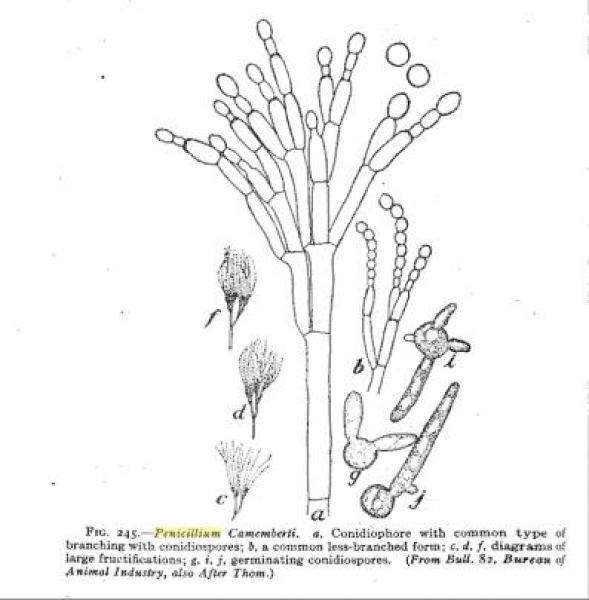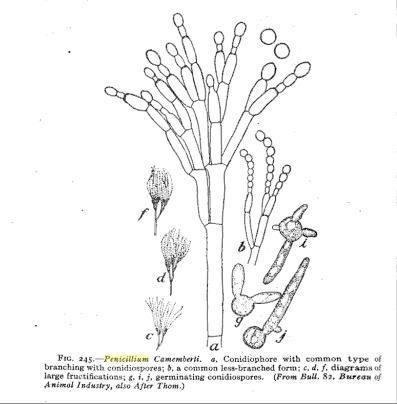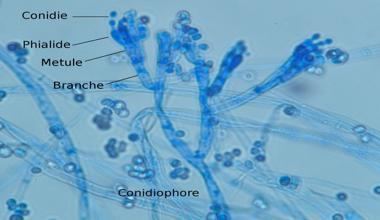Higher classification Penicillium | ||
 | ||
Similar | ||
Penicillium camemberti
Penicillium camemberti is a species of fungus in the family Trichocomaceae. It is used in the production of Camembert, Brie, Langres, Coulommiers and Cambozola cheeses, on which colonies of P. camemberti form a hard, white crust. It is responsible for giving these cheeses their distinctive taste. An allergy to the antibiotic penicillin does not necessarily imply an allergy to cheeses made using P. camemberti.
Contents

When making soft cheese that involves Penicillium camemberti, the mold may be mixed into the ingredients before being placed in the molds, or it may be added to the outside of the cheese after it is removed from the cheese molds. P. camemberti is responsible for the soft, buttery texture of Brie and Camembert, but a too high concentration may lead to an undesirable bitter taste.

Using PCR techniques, cheese manufacturers can control cheese making by monitoring the mycelial growth of P. camemberti. This is particularly significant, as controlling the growth is important to maintain desirable levels of compounds for flavor and to keep toxicity at a safe level.

History
The fungus was first described by Dr. Charles Thom in 1906. It is considered to be a great subject for experiments and tests as the fungus thrives well in artificial situations, creates dense, enzymatic mycelia, and is readily available in markets from cheeses. P. camemberti is also important economically for the cheese industry.
There are twenty-four isolates of Penicillia, resulting in “considerable taxonomic confusion”. However, these strains are only antigenically related, having similarities in micromorphology, growth rates, toxin production, and the ability to grow in water and at low temperatures. L. Polonelli et al. discovered that the twenty-four isolates can be grouped into nine subdivisions below the species level. This indicates that P. commune Thom is the wild-type, or the strain occurring in nature, ancestor of P. camemberti. The complete genome sequence of P. camemberti was published in 2014.
Toxic properties
As a fungus, Penicillium camemberti can produce toxins, in this case, cyclopiazonic acid. The amount of the mycotoxin produced depends on the strain of P. camemberti, as well as the temperature at which the culture is grown. Additionally, the toxin is typically more concentrated on the crust of the fungus rather than the inner part. In regards to safety, generally, consumers would only receive lower than a four microgram dose of cyclopiazonic acid. Still, it is advised to use weaker strains of the fungus, since the secretion of the toxin appears to be natural and necessary, but unhealthy for cheese consumers.
Use in other foods
Since P. camemberti is responsible for the main flavor and odor of popular cheeses, the fungus can be utilized for the flavoring of other foods, such as dry, fermented sausages. José M. Bruna and his team saw that the flavor comes from compounds produced by the fungus, such as ammonia, methyl ketones, primary and secondary alcohols, esters, and aldehydes, and decided to superficially inoculate P. camemberti on dry, fermented sausages to improve its sensory properties. P. camemberti undergoes proteolysis and lipolysis, which is the breakdown of proteins and lipids, resulting in free amino acids, free fatty acids, and volatile compounds that allow for the ripened flavor. The fungus created a mycelium, protecting the lipids within, allowing for better flavor and odor of sausages. This is the potential starter culture for dry, fermented sausages.
